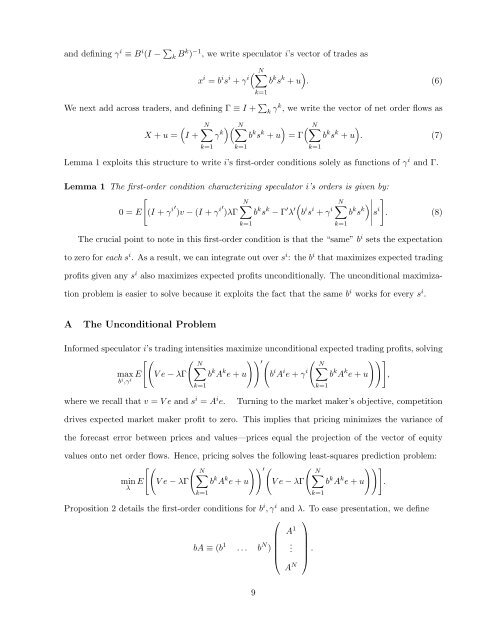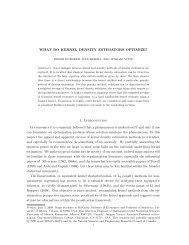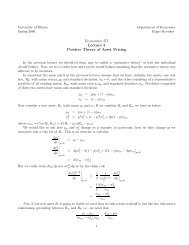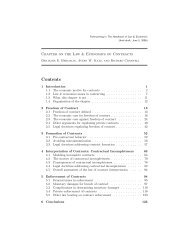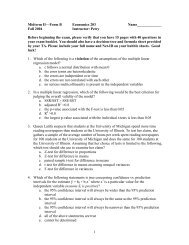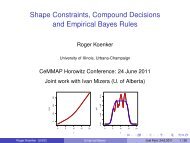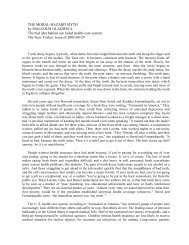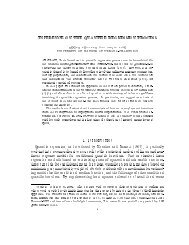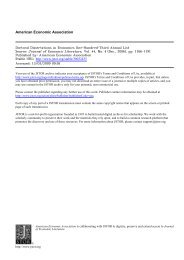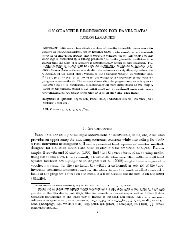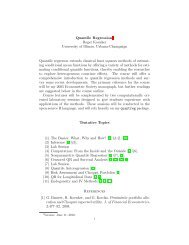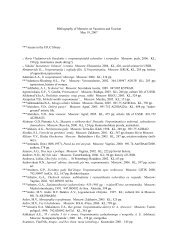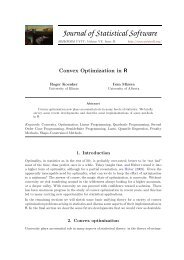Cross-Asset Speculation in Stock Markets∗ - Econometrics at Illinois ...
Cross-Asset Speculation in Stock Markets∗ - Econometrics at Illinois ...
Cross-Asset Speculation in Stock Markets∗ - Econometrics at Illinois ...
Create successful ePaper yourself
Turn your PDF publications into a flip-book with our unique Google optimized e-Paper software.
and def<strong>in</strong><strong>in</strong>g γ i ≡ B i (I − ∑ k Bk ) −1 , we write specul<strong>at</strong>or i’s vector of trades asx i = b i s i + γ i( N ∑k=1)b k s k + u . (6)We next add across traders, and def<strong>in</strong><strong>in</strong>g Γ ≡ I + ∑ k γk , we write the vector of net order flows asX + u =(I +N∑γ k)( ∑N )b k s k + u = Γk=1k=1( N ∑k=1)b k s k + u . (7)Lemma 1 exploits this structure to write i’s first-order conditions solely as functions of γ i and Γ.Lemma 1 The first-order condition characteriz<strong>in</strong>g specul<strong>at</strong>or i’s orders is given by:[N∑0 = E (I + γ i′ )v − (I + γ i′ )λΓ b k s k − Γ ′ λ ′( ∑Nb i s i + γ i b k s k)∣ ∣ ∣∣∣s]. i (8)k=1k=1The crucial po<strong>in</strong>t to note <strong>in</strong> this first-order condition is th<strong>at</strong> the “same” b i sets the expect<strong>at</strong>ionto zero for each s i . As a result, we can <strong>in</strong>tegr<strong>at</strong>e out over s i : the b i th<strong>at</strong> maximizes expected trad<strong>in</strong>gprofits given any s i also maximizes expected profits unconditionally. The unconditional maximiz<strong>at</strong>ionproblem is easier to solve because it exploits the fact th<strong>at</strong> the same b i works for every s i .AThe Unconditional ProblemInformed specul<strong>at</strong>or i’s trad<strong>in</strong>g <strong>in</strong>tensities maximize unconditional expected trad<strong>in</strong>g profits, solv<strong>in</strong>g[( ( N)) ′ ( (max E ∑N))]∑V e − λΓ b k A k e + u b i A i e + γ i b k A k e + u ,b i ,γ ik=1k=1where we recall th<strong>at</strong> v = V e and s i = A i e.Turn<strong>in</strong>g to the market maker’s objective, competitiondrives expected market maker profit to zero. This implies th<strong>at</strong> pric<strong>in</strong>g m<strong>in</strong>imizes the variance ofthe forecast error between prices and values—prices equal the projection of the vector of equityvalues onto net order flows. Hence, pric<strong>in</strong>g solves the follow<strong>in</strong>g least-squares prediction problem:[( ( N)) ′ ( (∑N))]∑m<strong>in</strong> E V e − λΓ b k A k e + u V e − λΓ b k A k e + u .λk=1Proposition 2 details the first-order conditions for b i ,γ i and λ. To ease present<strong>at</strong>ion, we def<strong>in</strong>e⎛ ⎞A 1bA ≡ (b 1 ... b N )⎜ .⎟⎝ ⎠ .A Nk=19


